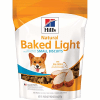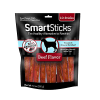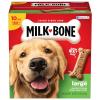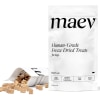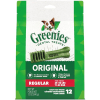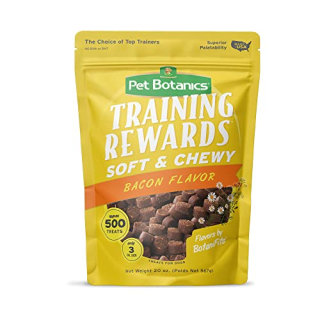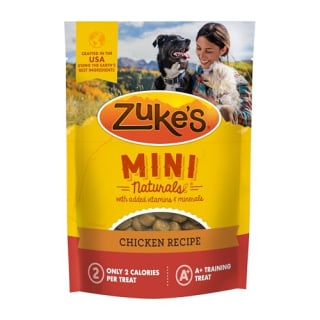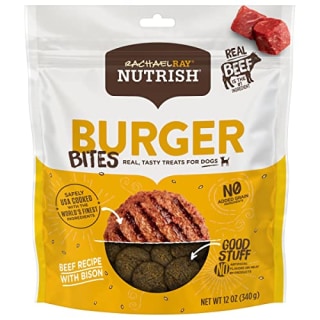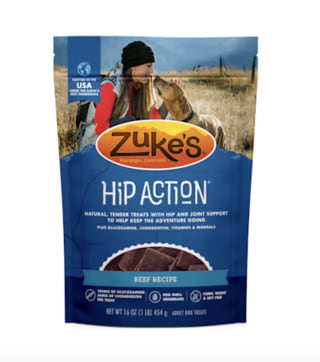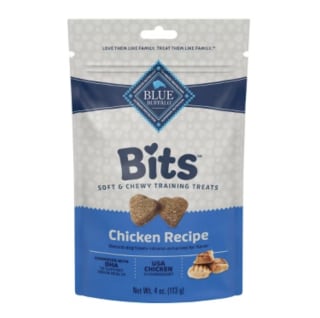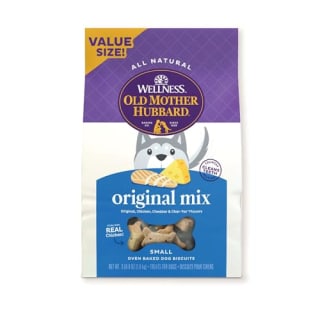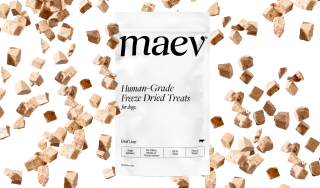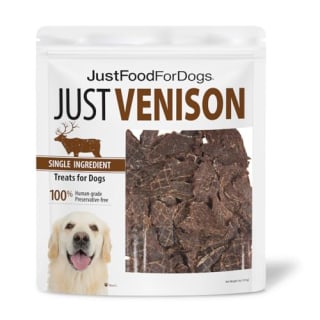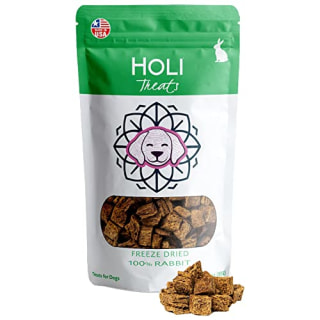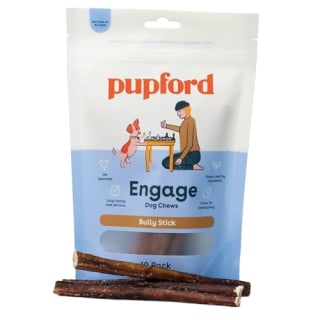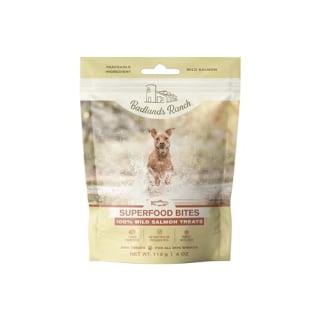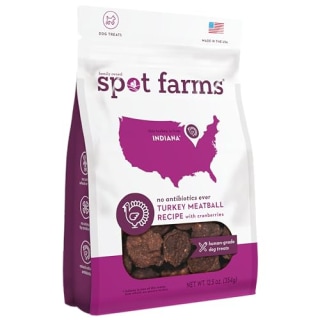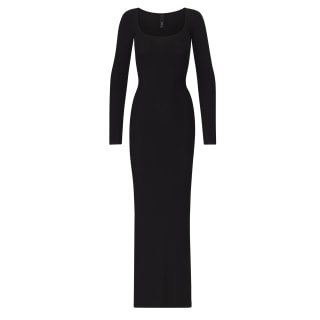Everyone loves to spoil their pet with toys and treats, whether it's an afternoon pick-me-up or a reward for good behavior. Dogs love food rewards for many reasons, mainly because they’re a welcome change from their daily food. But if you’ve been giving your pup scraps from your dinner plate, you might want to rethink what (and how much) you’re feeding them. Human food, even in small treat-sized amounts, can take up too many of your pet’s daily calories and quickly add up to extra pounds, experts say.
To help you choose the right treats for your dog, I consulted veterinarians and veterinary technicians about how to shop for the best ones, and compiled their recommendations as well as NBC Select staff favorites to consider.
How I picked the best dog treats
Treats should only be considered as one part of your dog’s daily diet, which means you should give them out in moderation to avoid going over your pup’s recommended calorie count. Keep in mind:
- Nutritional balance: Look for treats that clearly state the number of calories in each one and include feeding recommendations on the packaging. You can also keep an eye out for the Association of Feed Control Officials’ (AAFCO) nutritional adequacy label on the bag, but unlike dog food, not all treats are required to have that label on their packaging (more on nutritional balance below).
- Ingredients: Avoid ingredients that could potentially irritate your dog’s stomach: artificial sweeteners like xylitol, artificial dyes, excessive salt — which will make them thirstier — and syrups and molasses — which are high in sugar, says Caylee Freels, a licensed veterinary technician at VCA White Lake Animal Hospital. Consider treats that contain dog-safe fruits and vegetables like carrots, green beans, apples and bananas that offer very few calories and have good nutritional value, experts say.
- Size: Choose a treat that’s proportional to your dog’s size. Giving your dog a treat that’s too big or too small for them can turn into a choking hazard, experts say. You can also break up larger biscuits to cut down on the calories per treat, says Dr. Kristen L. Nelson, a board-certified veterinarian author of “Coated With Fur: A Vet’s Life.”
Want more from NBC Select? Sign up for our newsletter, The Selection, and shop smarter.
Best dog treats of 2026
These dog treats align with expert guidance: each one features a nutrition label on its packaging that indicates the number of calories and fat content per serving as well as the ingredients. Most of them also come in various sizes (or can be broken up into smaller pieces) to accommodate different size dogs and breeds.
Best treat sticks
These beef-flavored, rawhide-free sticks are a favorite of my 15-pound, 7-year-old havanese and bichon frise mix, Bella, who has half of one for breakfast every morning. These sticks are harder than most dog treats, so they keep her entertained while the chewing helps keep her teeth and gums healthy. They’re also made with real beef and enriched with vitamins and minerals that make digesting them easier, according to the brand.
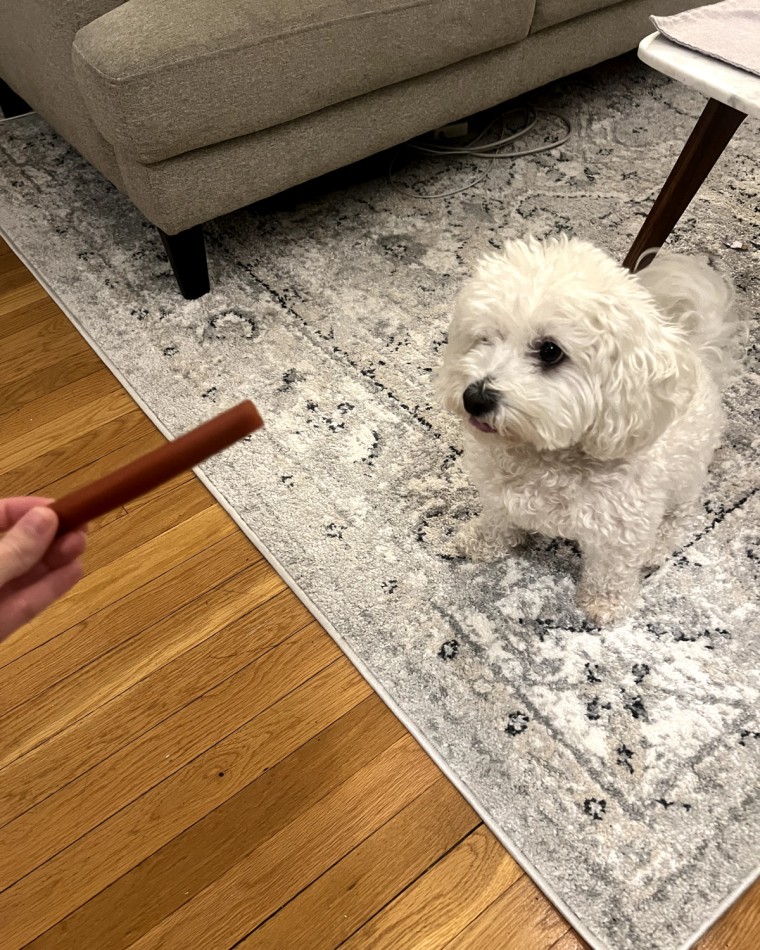
Best training treats
These Pet Botanics dog treats are three calories each and made with real pork liver. I give Bella these tasty treats when teaching her new commands and to reward good behavior. They come as small, low-calorie pellets, so I can give her multiple treats at a time while still keeping track of her nutritional intake for the day. Plus, she adores the bacon flavor.
Best overall treats
These chicken-flavored dog biscuits, an NBC Select Pet Award winner, are a healthy alternative to higher-calorie treats, which can have negative health impacts over time. They don’t have corn or artificial colors and flavors, according to the brand. Opting for low-calorie treats like these can keep your pet within the AAFCO-recommended daily nutrition intake, experts say. It comes in two bag sizes: small and medium.
Best low-calorie treats
The Zuke’s Mini Naturals treats are a great training treat option, says Nelson. They come in tiny morsels, so you don’t have to break them up as you’re working with your dog on a new skill. Mini Naturals are wheat-free and corn-free for dogs who may have stomach sensitivities or allergies, and they contain no added animal fat, artificial colors or artificial flavors, according to the brand.
Best beef-flavored treats
These beef-flavored Rachel Ray Nutrish dog treats are a favorite of Daruvuri’s Bandit, who also loves the roasted chicken-flavored ones from the brand. The treats are soft enough to break apart easily for smaller dogs and are made without artificial flavors or meat by-products for sensitive stomachs, according to the brand.
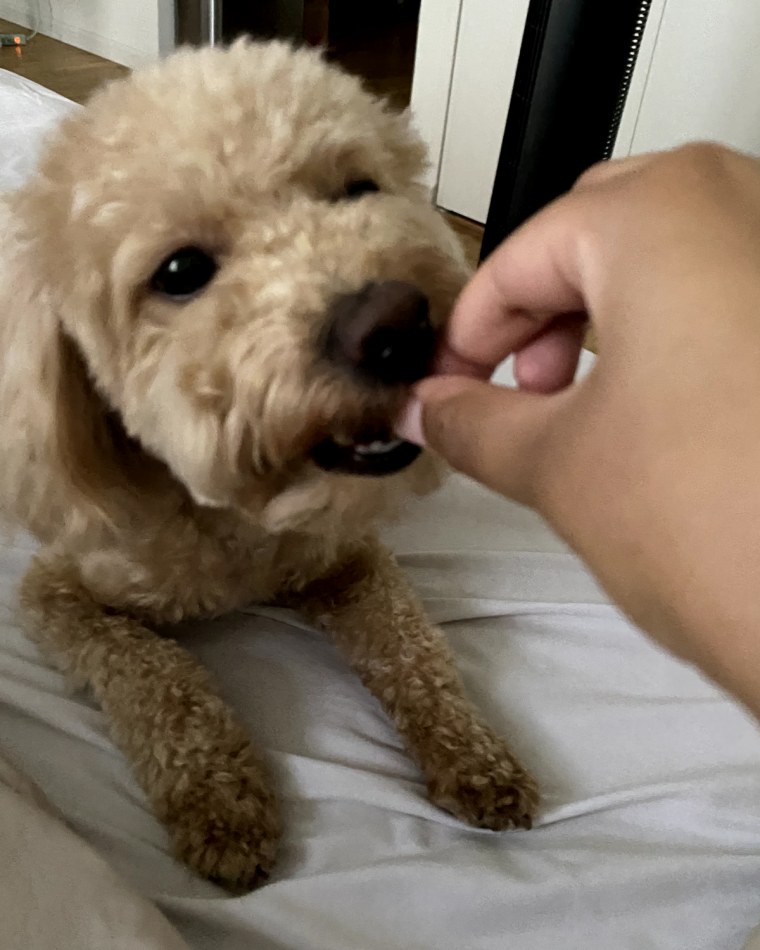
Best treats for joint health
These treats are great for dogs with joint issues. NBC Select reporter Zoe Malin feeds these to her 12-year-old yellow lab Chance because they contain egg shell membrane, which can help improve hip and joint health, according to Zuke’s. These soft treats also contain antioxidant-rich whole food berries as well as essential vitamins and minerals for dogs.
Best dental treats
These dental treats have a stamp of approval from the Veterinary Oral Health Council, which means a group of veterinary dentists and dental scientists confirmed the treats reduce plaque and tartar build-up in dogs. The treats help maintain gum and dental health as well as help freshen your pup’s breath, experts say. They’re also made with easy-to-digest ingredients, vitamins and minerals, according to the brand. I feed the brand’s Teenie Greenies to my dog, Bella, and they’ve helped avoid any issues with her teeth and gums, which her breed is predisposed to. She also loves the taste of them and gobbles them up quickly.
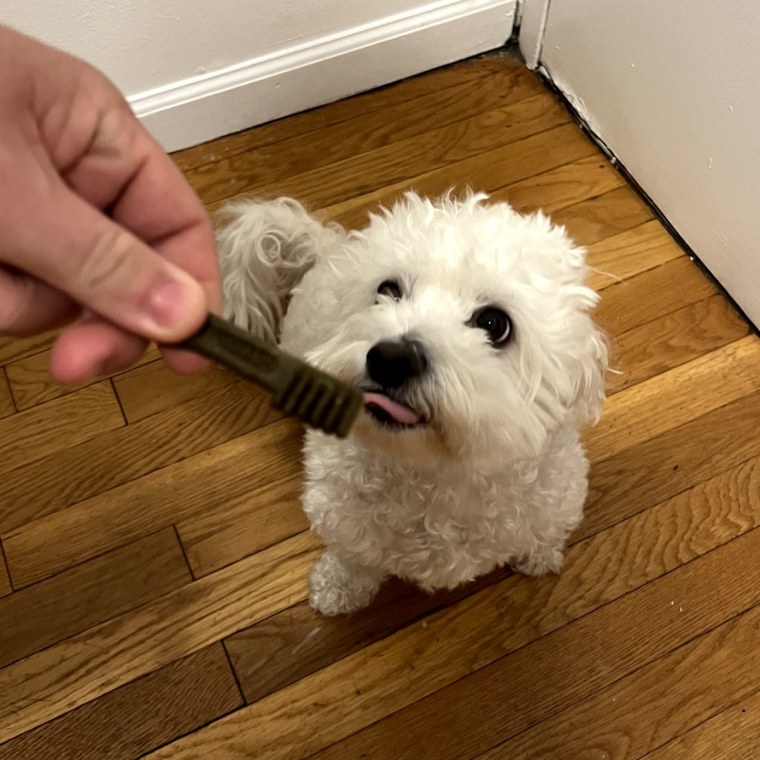
Best puppy treats
These real meat-flavored training treats from Blue Buffalo — which former NBC Select social commerce editor Sadhana Daruvuri feeds her 2-year-old maltipoo Bandit — can be great for both puppies and adult dogs. These treats are made with omega-3 and omega-6 fatty acids to keep your dog’s skin and coat healthy. They also don’t contain soy, wheat or artificial flavors and preservatives, according to Blue Buffalo. Plus, they come in a portable bag if you need to take them on the go, says Daruvuri.
Best variety pack treats
Old Mother Hubbard has a variety of tasty treat flavors, including peanut butter and apples and bacon and cheddar cheese. I give this small-sized variety pack to Bella, who loves the diversity of the flavors. This mix comes with the brand’s original flavor, along with chicken, cheddar and Char-Tar (a mixture of oatmeal, apples and carrots).
Best freeze-dried treats
These freeze-dried dog treats are made from 100% beef liver and are great for dogs with sensitive stomachs who may need a single-ingredient diet. “They have one ingredient, so they could not be more natural. There are also no filler ingredients, so I love knowing that when I’m going to give my dogs treats, it’s not just ‘junk food,’” says Malin. “Plus, Chance is 12 years old, so I have to watch what he eats.” The brand recommends feeding your pup no more than a small handful of these treats per day.

Best high protein treats
Bella is obsessed with these venison treats, the newest addition to my treat supply — they’re the ones I typically reach for when she’s exceptionally good or needs some positive reinforcement. The single-ingredient treats are made from cooked and dehydrated protein. Though the slices are on the larger and thicker side, I find them easy to break apart (which is much better for Bella’s small frame).
Best treats for small dogs
Malin feeds these treats to her picky 5-month-old puppy, Mabel. “She wouldn’t eat a bunch of others I bought when I first brought her home, which made training challenging. But now that I found these and discovered how much she loves them, she’ll basically do anything for them,” she says. They’re crunchy yet soft, which makes them easy to break into small pieces. “I usually break one treat up into three or four pieces since she’s seven pounds and has a small mouth,” says Malin. She also hides the small treats in puzzles or toys to keep her puppy entertained
Best soft treats
This semi-soft peanut butter-flavored treat from Kong — which makes some of our experts’ favorite dog toys — comes in a dispenser that works like spray cheese, so you can put it inside of a chew toy to keep your dog entertained. You can also place a treat-filled toy in the freezer before handing it to your pup to make it last longer, according to the brand.
Best treats for large dogs
These are the largest classic bone-shaped dog biscuits on this list, and they are a great option if the smaller treats just don’t cut it for your large breed pup. My family dogs have included medium to large breeds like doberman pinschers and golden retrievers, and these biscuits were always a staple in my house. The crunchy treats are beef-flavored and help reduce tartar build-up on their teeth, according to the brand. They also come in a large, 10-pound box, so you won’t have to worry about running out any time soon.
Best long-lasting treats
These rawhide-free bully sticks come in handy when you need a long-lasting treat to occupy your dog when they’re home alone or in stressful situations, like if they’re in a car or around lots of people. I give Bella the skinny version of these Pupford bully sticks (which are made for small dogs) when we’re traveling because they last for hours and keep her entertained, especially on an airplane. The sticks help clean her teeth and scrape away plaque as she chews, too. The brand also has other long-lasting treats, including dog chews in flavors like elk antler and beef tendon, and beef jerky treats.
Best salmon-flavored treats
These freeze-dried treats are a favorite of former NBC Select associate reporter Bianca Alvarez’s 8-year-old pitbull Baylor. “My dog’s a picky eater with a sensitive stomach, so I’m usually nervous to introduce new dog food or treats to her. Since these only have one ingredient — freeze-dried wild salmon — I took the risk, and luckily it paid off,” says Alvarez. “She’s been loving them, listening more and I haven’t noticed any stomach problems since introducing them into her routine.”
Best turkey-flavored treats
These treats from Spot Farms have a blend of turkey (the first ingredient), high-fiber rolled oats, honey and cranberries. They’re free from fillers, artificial flavors, preservatives and colors, and you can feed them to your dog whole or split them up into small training-sized treats to give throughout the day, according to the brand.
Best stuffed treats
These rawhide-free treats from NBC Select staff-favorite brand Smartbones are filled with a pork-flavored chew center to add a surprise boost of flavor for your canine friend. They’re also made with real chicken and vegetables, according to the brand. Smartbones also has a peanut butter option with a pork-flavored center, as well as beef and chicken-flavored options. If you have a smaller dog, you may want to consider the brand’s mini treats since these chew sticks may be hard for them to break into pieces.
How to shop for dog treats
Treats should only be given in moderation, which may mean your dog shouldn’t get them on a daily basis. “Too many treats can interfere with the balance of your pet’s core diet — it’s recommended that treats make up no more than 10% of a pet’s daily calorie intake,” says Dr. Lori Teller, a board-certified veterinarian and former president of the American Veterinary Medical Association.
To determine what treats are best for your dog, our pet experts recommend looking at the ingredients, size and calorie count of each treat. They also discussed other types of treats — like dental treats and grain-free options — and whether they can benefit your dog’s health.
Determine nutritional balance
Keep in mind that treats aren’t typically designed to be nutritionally balanced. Deciding how to add treats into your dog’s diet is the biggest consideration when it comes to your own research: “If you start feeding your dog a lot of treats and cut back on their kibble, you start running into nutrient deficiencies,” says Dr. Joe Wakshlag, professor of clinical nutrition and sports medicine and rehabilitation at Cornell College of Veterinary Medicine.
Too many treats can also result in diarrhea and occasional vomiting, so it’s important to choose brands that clearly state the calories contained in each treat and include feeding recommendations on the back of the packaging, says Freels. If you’re in doubt, The Ohio State University Veterinary Medical Center also offers a handy daily calorie calculator for pets.
If you want to be extra sure the treats you’re feeding your dog are healthy, look for the AAFCO nutritional adequacy label (which is usually in small print on the bag). However, unlike dog food, treats don’t have to have the AAFCO label on their packaging — the association says it recognizes that treat products don’t meet the nutritional adequacy requirements for a complete and balanced meal, which is why they must clearly display the terms “snack” or “treat” on the front label.
Analyze good (and bad) ingredients
Dog owners should avoid artificial sweeteners like xylitol in the dog treats they buy, says Freels. Other things to avoid include artificial colors, excessive salt (which will increase thirst) and syrups and molasses (which are high in sugar). Be mindful of foods like grapes or raisins, which can be healthy for people but toxic to dogs, says Nelson. If you’re not sure about a certain food, the American Society for the Prevention of Cruelty to Animals (ASPCA) maintains a list of foods that can be harmful to your pet.
If you want to reduce their calorie intake, dog-safe fruits and vegetables — including bell pepper, carrots, green beans, apples and bananas, to name a few — offer very few calories and have some good nutrition to them, according to Wakshlag. “And it’s not diluting down the calories that they get from their food — those are things you can get a lot more of as treats than commercial treats or pieces of steak that are going to be calorie dense,” he says.
Find the right size
While watching a puppy struggle with an oversized bone looks adorable, giving a dog a treat that’s too big or too small for them can be dangerous. “The size of the treat should be proportional to the size of your dog. Very small dogs shouldn’t have large treats and [vice versa],” says Nelson. Keep an eye on your dog while they’re chewing larger treats like rawhide chews that can break apart and turn into choking hazards, and break up big biscuits to cut down on the calories per treat, too, she says.
Size also depends on what you are using the treat for: training versus mental stimulation or enrichment. Training treats are going to be very small, which means more can be given as a reward for positive behavior. Regular treats, on the other hand, are larger, such as bully sticks, bones and dog chews, and should be used only for enrichment or mental stimulation, according to Freels. Too much of a large treat can cause GI Issues, so these enrichment treats should be given less regularly. If you’re using treats for training, “very small treats — the size of a thumbnail — are going to be best so more can be given without causing any GI indiscretion,” says Freels.
Meet our experts
At NBC Select, we work with experts who have specialized knowledge and authority based on relevant training and/or experience. We also take steps to ensure all expert advice and recommendations are made independently and without undisclosed financial conflicts of interest.
- Caylee Freels is a licensed veterinary technician at VCA White Lake Animal Hospital.
- Dr. Kristen Nelson is a board-certified veterinarian author of “Coated With Fur: A Vet’s Life.”
- Dr. Lori Teller is a board-certified veterinarian and the former president of the American Veterinary Medical Association.
- Dr. Joe Wakshlag is a professor of clinical nutrition and sports medicine and rehabilitation at Cornell College of Veterinary Medicine.
- Dr. Brian Roberts is a board-certified veterinarian and regional medical director in the Mid-Atlantic region with VCA Animal Hospitals.
Why trust NBC Select?
I am an editor at NBC Select who covers a variety of pet essentials, including dog food, travel carriers and shampoos. For this article, I spoke to five veterinarians and dog experts about how to shop for the best treats for your dog, including health considerations and nutritional value. I also compiled their recommendations for the best dog treats to consider, as well as options that NBC Select staff give their own dogs.
Catch up on NBC Select’s in-depth coverage of tech and tools, wellness and more, and follow us on Facebook, Instagram, Twitter and TikTok to stay up to date.


